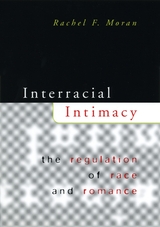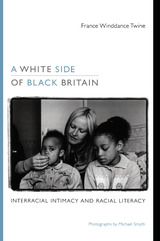2 books about Interracial Intimacy

Interracial Intimacy
The Regulation of Race and Romance
Rachel F. Moran
University of Chicago Press, 2003
As late as the 1960s, states could legally punish minorities who either had sex with or married persons outside of their racial groups. In this first comprehensive study of the legal regulation of interracial relationships, Rachel Moran grapples with the consequences of that history, candidly confronting its profound effects on not only conceptions of race and identity, but on ideas about sex, marriage, and family.
"A good introduction to an issue too often overlooked. . . . The writing is clear and accessible, the evidence is evocative, and the ideas are challenging."—Beth Kiyoko Jamieson, Law and Politics Book Review
"U. S. government bodies have tried to regulate interracial intimacy from the day Pocahontas married John Rolfe up through Loving v. Virginia, which found antimiscegentation laws unconstitutional in 1967. . . . The weirder anecdotes from our racial history enliven this study, which is likely to become a classic in its field."—Publishers Weekly
"Moran examines the history of U. S. regulation of cross-racial romance, considering the impact of that regulation on the autonomy of individuals and families as well as on racial identity and equality. . . . She is attuned to the nuances of race in this polyglot nation, and supplies thoughtful analysis of these nuances."—Booklist
"A good introduction to an issue too often overlooked. . . . The writing is clear and accessible, the evidence is evocative, and the ideas are challenging."—Beth Kiyoko Jamieson, Law and Politics Book Review
"U. S. government bodies have tried to regulate interracial intimacy from the day Pocahontas married John Rolfe up through Loving v. Virginia, which found antimiscegentation laws unconstitutional in 1967. . . . The weirder anecdotes from our racial history enliven this study, which is likely to become a classic in its field."—Publishers Weekly
"Moran examines the history of U. S. regulation of cross-racial romance, considering the impact of that regulation on the autonomy of individuals and families as well as on racial identity and equality. . . . She is attuned to the nuances of race in this polyglot nation, and supplies thoughtful analysis of these nuances."—Booklist
[more]

A White Side of Black Britain
Interracial Intimacy and Racial Literacy
France Winddance Twine
Duke University Press, 2010
A White Side of Black Britain explores the racial consciousness of white women who have established families and had children with black men of African Caribbean heritage in the United Kingdom. Filling a gap in the sociological literature on racism and antiracism, France Winddance Twine introduces new theoretical concepts in her description and analysis of white “transracial” mothers raising their children of African Caribbean ancestry in a racially diverse British city. Varying in age, income, education, and marital status, the transracial mothers at the center of Twine’s ethnography share moving stories about how they cope with racism and teach their children to identify and respond to it. They also discuss how and why their thinking about race, racism, and whiteness changed over time. Interviewing and observing more than forty multiracial families over a decade, Twine discovered that in most of them, the white woman’s racial consciousness and her ability to recognize and negotiate racism were derived as much from her relationships with her black partner and his extended family as from her female friends. In addition to the white birth mothers, Twine interviewed their children, spouses, domestic partners, friends, and members of their extended families. Her book is best characterized as an ethnography of racial consciousness and a dialogue between black and white family members about the meaning of race, racism, and whiteness. It includes intimate photographs of the family members and their communities.
[more]
READERS
Browse our collection.
PUBLISHERS
See BiblioVault's publisher services.
STUDENT SERVICES
Files for college accessibility offices.
UChicago Accessibility Resources
home | accessibility | search | about | contact us
BiblioVault ® 2001 - 2024
The University of Chicago Press









